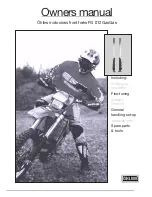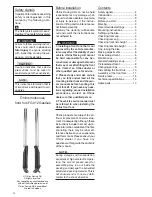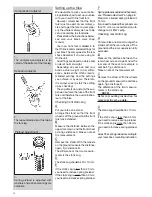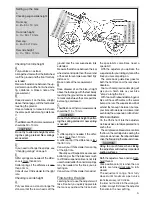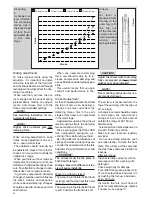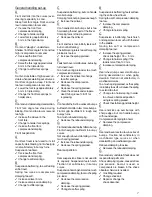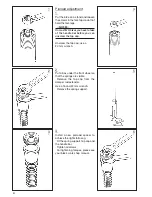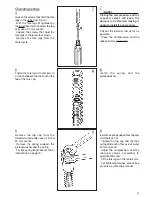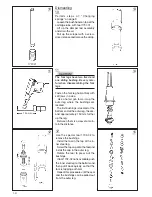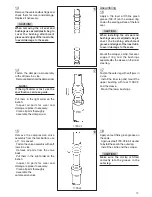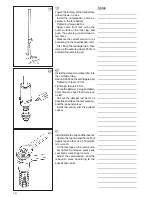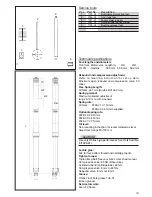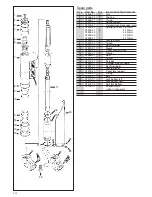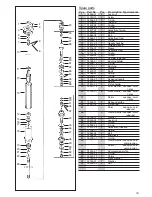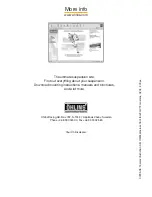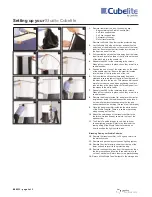
7
General handling set-up
A
Front end falls into the curves (over-
steering) especially in sand.
Steep front fork angle. Front end too
low in comparison to rear end.
Increas the front fork
compression damping.
Change to harder springs.
Lower fork leg approximately
5 mm in the triple clamp.
B
Front end ”ploughs”, understeers.
Shallow front fork angle. Front end too
high in comparison to rear end.
Decrease the front fork
compression damping.
Raise the fork legs approximately
5 mm in the triple clamp.
Change to softer fork springs.
C
Front end unstable at high speed, un-
stable when accelerating out of curves.
Front fork angle too steep. Front end
too low in comparison to rear end.
Lower the fork legs approximately
5 mm in triple clamp.
Change the front fork springs to
harder ones.
D
Front end unstable during deceleration.
Front fork angle too steep during
braking. Front end too low or rear end
too high.
Increase the oil level in the
front fork.
Change to harder fork springs.
Increase the front fork
compression damping.
Front suspension.
A
Front fork travel is not used to its full
capacity. Harsh feeling, front wheel grip
is not satisfactory in bumpy turns.
Suspension too hard.
Decrease the front fork
compression damping.
Change to softer springs.
B
Suspension bottoming, too soft during
entire travel.
Spring too weak or compression
damping too soft.
Increase oil level 5 mm.
Increase compression damping.
Change to stiffer springs.
C
Suspension bottoming, but can handle
smaller bumps.
Damping force not progressive enough.
Increase the oil level.
D
Can handle smaller bumps but is too
hard during the last part of the travel.
Damping force is too progressive.
Decrease the oil level.
E
Front end feels low, initially feels soft,
but is not bottoming.
The initial spring rate is too soft or spring
preload is too low.
Increase the spring preload.
E
Feels harsh over small bumps, but using
full wheel travel.
Too much spring preload or too much
compression damping.
Increase the oil level or change
to softer springs.
Decrease the compression
damping.
Decrease the spring preload.
Clean the oil seals and scrapers.
Use Öhlins grease 148-01 for
regreasing.
F
Can handle the first in a series of bumps
but feels hard after a few more bumps.
Frontal grip insufficient in rough and
bumpy turns.
Too much rebound damping.
Decrease the rebound damping.
G
Front end rebound too fast after a bump.
Front wheel grip insufficient in bumpy
curves.
Not enough rebound damping, or too
much spring preload
Increase the rebound damping.
Decrease the spring preload.
Rear suspension.
A
Rear suspension stroke is not used to
its capacity. Suspension feels harsh.
Traction not satisfactory in bumpy
curves.
Suspension hard in general or too much
compression damping, too much spring
pre-load.
Decrease the compression
damping.
Decrease the spring preload.
Change to softer spring.
B
Suspension is bottoming, feels soft dur-
ing the entire wheel travel.
Spring too soft, compression damping
too low.
Increase the compression
damping.
Change to harder spring.
C
Suspension is bottoming, feels harsh
and sags down too much with the rider
in the saddle.
Spring too soft or compression
damping too low.
Increase the spring preload,
check ride height. 95 +- 5 mm.
Change to harder spring if the
load is more than 100 mm.
Increase compression damping.
D
Rear wheel jumps over small bumps
during deceleration or when going
downhill. Traction not satisfactory in
washboard curves.
Too much spring preload, as the spring
is probably too soft, will cause the spring
to extend too fast.
Change to a harder spring in order
to achieve a balanced position
using less spring preoad.
Check the static sag and ride height.
E
Rear end kicks up over bumps with
sharp edges, but can handle bumps
with round edges.
Compression damping too hard.
Decrease the compression
damping.
F
Rear end becomes too low in series of
bumps. Traction not satisfactory in
washboard type curves or when
decelerating on washboard ground.
Rebound damping too slow.
Decrease the rebound damping.
G
Rear end very unstable. Shock does not
respond to adjustments.
Shock damping is gone, caused of low
gas pressure, bad oil is used, or
components are broken in the shock
absorber. Service is needed.
Gas filling required.
Change shock oil.
Repair or change the
shock absorber.

